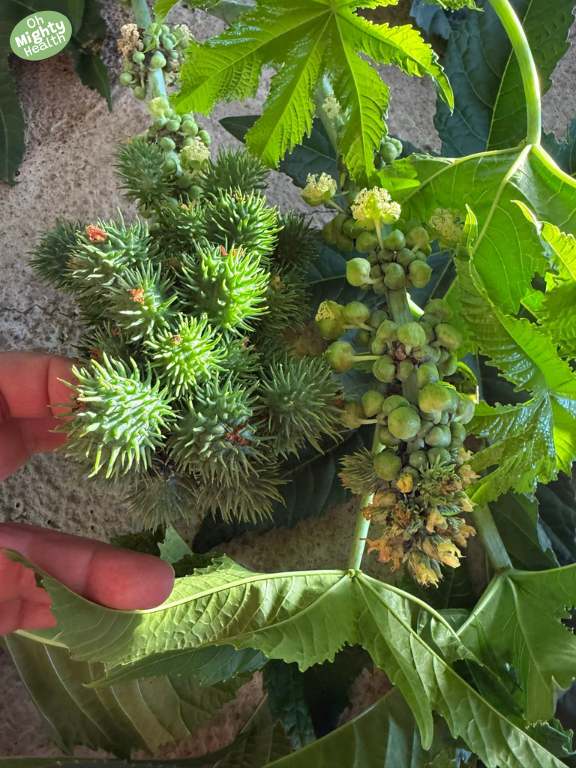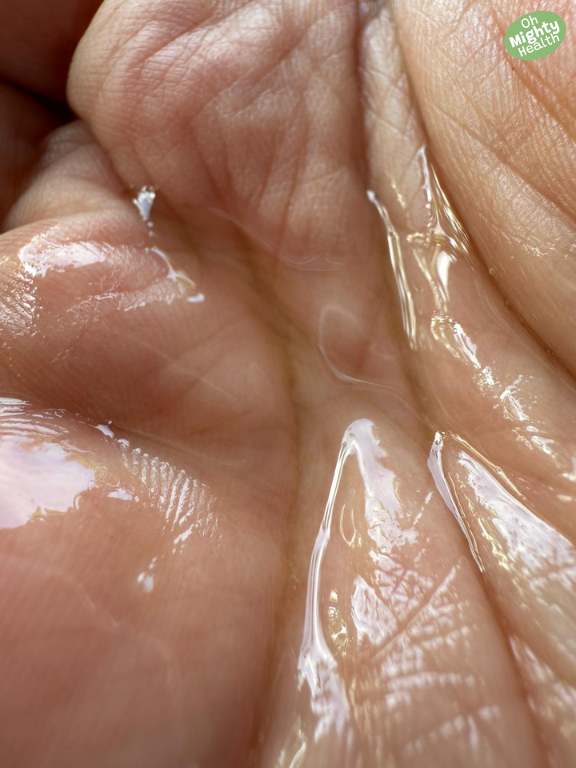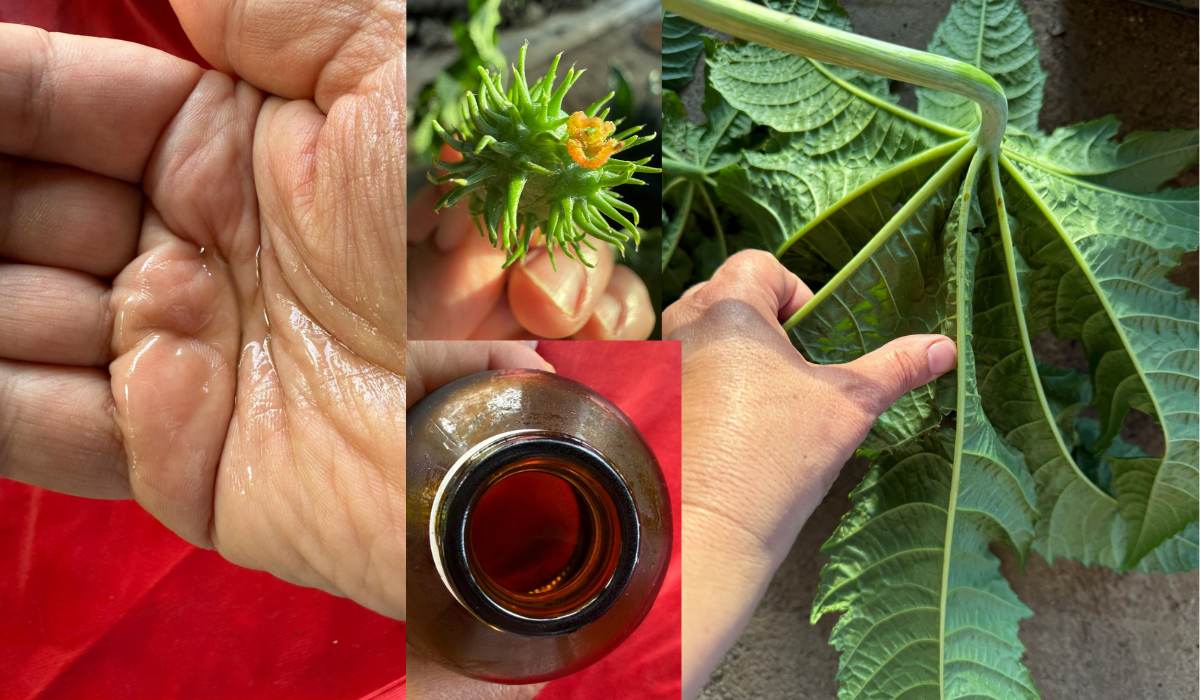Castor Oil: What’s Inside & How It Works for Your Skin & Hair
When it comes to understanding oils, it takes years of learning, research, and experience—reading books, studying how oils work, where they come from, and how plants produce them. But my job at Oh Mighty Health is to make this knowledge a lot easier for you.
This article will break down castor oil’s components, making it super clear what’s inside and how it benefits your skin and hair. To keep things simple and digestible, I’ve added tables so you can quickly see what each component does.
And for those of you who love the science behind skincare, this will be a deep dive into castor oil’s fatty acids, antioxidants, and other compounds—but in a way that’s easy to follow and useful in real life… (hopefully!).
DISCLAIMER: I recommend products below. If you buy through my links I might earn a commission at no extra cost to you.
What Makes Castor Oil So Unique?
Before jumping on a trend, it’s important to understand why castor oil stands out—because every oil has its own unique magic. Castor oil isn’t just another plant oil; what makes it truly different is its high concentration of ricinoleic acid.
Most oils contain a blend of fatty acids, but castor oil is around 85-90% ricinoleic acid—a rare fatty acid with powerful moisturising, antimicrobial, and anti-inflammatory properties. This is what gives castor oil its thick, almost sticky texture and why it’s so effective for deep hydration, soothing irritation, and even scalp health.
That being said, every oil is special in its own way. Castor oil just happens to be one of the few that contains this much ricinoleic acid, making it a one-of-a-kind powerhouse for skin and hair.

HERE’S MY RECOMMENDED CASTOR OIL (COLD PRESSED AND UNREFINED, ORGANIC OF COURSE!)
1. Castor Oil’s Fatty Acids and What They Do for Your Skin
Let’s talk about fatty acids—don’t let the word “acid” scare you! All plant oils are made up of fatty acids, and they’re essential for keeping your skin healthy, hydrated, and protected.
These fatty acids come from the seeds of plants, where the oil is stored. The unique blend of fatty acids in each oil determines how it feels, how it absorbs, and what benefits it offers to your skin.
To really understand why castor oil works the way it does, we need to break down its fatty acid profile. The table below will help you focus on the key skin benefits—so you’ll see why castor oil feels thick and sticky, how it locks in moisture, and why it’s so different from other oils.
| Fatty Acid | Percentage | Skin Benefits | Texture/Feel |
|---|---|---|---|
| Ricinoleic acid** | ~85-90% | Deeply moisturizing, antibacterial, anti-inflammatory | Thick, sticky |
| Oleic acid | ~4-5% | Softens skin, locks in moisture | Rich, smooth |
| Linoleic acid | ~4-5% | Helps with acne-prone skin, balances sebum | Lightweight, absorbs well |
| Palmitic acid | ~1% | Strengthens skin barrier, emollient | Waxy, slightly occlusive |
| Stearic acid | ~1% | Protective barrier, enhances texture | Thick, creamy |
About Ricinoleic acid: Ricinoleic acid is the main fatty acid in castor oil—making up about 85-90% of it. It’s a monounsaturated omega-9 fatty acid, which means it’s thicker and more viscous than other common fatty acids. Ricinoleic acid is deeply hydrating, anti-inflammatory, and antibacterial, which makes it great for dry skin, scalp health, and soothing irritation.

HERE’S MY RECOMMENDED CASTOR OIL (COLD PRESSED AND UNREFINED, ORGANIC OF COURSE!)
2. I Think It is Important to Take a Closer Look at Castor Oil’s Fatty Acids
Now that we know which fatty acids are in castor oil, let’s take a closer look at what each one does and why it matters for your skin.
1. Ricinoleic Acid (The Main and Most Important Acid in Castor Oil)
Ricinoleic acid is what makes castor oil truly unique—you won’t find this much of it in almost any other oil. It’s a thick, sticky, deeply hydrating fatty acid that creates a protective layer over the skin, locking in moisture like a natural barrier. But it’s not just about hydration—it also has antibacterial and anti-inflammatory properties, which means it can help with irritated skin, acne, and even scalp health. This is why castor oil is often recommended for dry, sensitive, or troubled skin—it soothes, protects, and keeps moisture where it belongs.
2. Oleic Acid (Softens)
Oleic acid is a rich, smooth fatty acid that helps your skin stay soft, plump, and hydrated. If your skin ever feels tight and rough, oleic acid works to replenish lost moisture and strengthen your skin barrier. It’s naturally found in many oils, like olive oil, and is great for dry or mature skin because it prevents water loss and keeps the skin feeling supple. In castor oil, there’s only a small amount, but it helps balance out the thick texture, making it a little easier to apply and spread.
3. Linoleic Acid (Balances)
Linoleic acid is what keeps oil production in check, making it especially good for acne-prone or combination skin. Unlike thicker fatty acids, linoleic acid is lightweight and easily absorbed, meaning it won’t clog pores. It also helps to soothe inflammation and support your skin barrier, which is why it’s often found in oils used for acne-prone skin. Castor oil doesn’t have much of it, but the little it does contain adds a touch of balance, making it useful even for those with oilier skin.
4. Palmitic Acid (Protects)
Palmitic acid acts like a shield for your skin—it’s a waxy, occlusive fatty acid that helps create a barrier against moisture loss. This makes it perfect for dry or damaged skin that needs extra protection. It’s also naturally found in human skin, which is why many rich, creamy skincare products include it. In castor oil, there’s only a tiny bit, but it adds to the nourishing, protective effect of the oil, making it even better for keeping skin soft and hydrated.
5. Stearic Acid (Smooth Texture)
Stearic acid is a thick, creamy fatty acid that gives castor oil its smooth texture. It works by softening and conditioning the skin while adding a bit of structure to the oil itself. This makes castor oil feel rich and luxurious on the skin, rather than too runny or greasy. Even though castor oil only has a small amount, stearic acid contributes to its protective and deeply moisturising nature.
FUN FACT: The word “castor” in castor oil and the castor plant (Ricinus communis) is believed to have originated from the Latin word castor, meaning beaver. This is because castor oil was historically used as a substitute for castoreum, a substance derived from the scent glands of beavers and used in medicine and perfumery.
3. The Extra Good Stuff in Castor Oil: Antioxidants & More
Castor oil isn’t just about fatty acids—it also contains antioxidants, vitamins, and plant compounds that give it even more skin-loving benefits. These extra compounds help protect, repair, and nourish the skin, making castor oil a powerful natural skincare ingredient.
1. Vitamin E & Antioxidants: Skin’s Natural Defence
One of the most important antioxidants in castor oil is vitamin E, a well-known skin protector. Antioxidants help fight free radicals, which are unstable molecules that can damage skin cells and speed up signs of aging. By neutralising these molecules, vitamin E helps keep your skin looking fresh, smooth, and healthy.
Here’s a look at the key antioxidants in castor oil and what they do:
Key Antioxidants in Castor Oil
| Antioxidant | What It Does for Skin | Extra Benefits |
|---|---|---|
| Vitamin E | Protects against free radicals, helps skin repair | Softens and smooths skin |
| Flavonoids | Soothes irritation, reduces redness | Found in many plant-based oils |
| Phenolic Compounds | Antimicrobial, supports skin barrier | Can help with minor skin issues |
These antioxidants add an extra layer of protection to your skin, helping to repair damage, reduce irritation, and keep your skin barrier strong.
2. Phytochemicals & Other Minor Compounds
Besides fatty acids and antioxidants, castor oil contains tiny amounts of plant compounds that contribute to its nourishing and protective properties. These natural elements work in the background, supporting skin health and boosting the oil’s overall effectiveness.
Phytochemicals & Their Effects
| Phytochemical | What It Does | Found in Other Oils? |
|---|---|---|
| Sterols | Strengthens skin barrier, locks in moisture | Yes, in shea butter and avocado oil |
| Triterpenoids | Anti-inflammatory, helps with skin regeneration | Common in many healing plant oils |
| Squalene | Lightweight hydration, antioxidant-rich | Also in olive oil and jojoba oil |
Though these compounds are present in smaller amounts, they still add to castor oil’s power—helping to calm irritation, protect the skin, and provide long-lasting moisture.
4. Is Castor Oil Right for Your Skin Type?
Castor oil is a versatile oil, but it doesn’t work the same way for everyone. Whether your skin is dry, oily, sensitive, or acne-prone, the way castor oil interacts with it depends on its unique composition—especially its high ricinoleic acid content.
The table below will help you quickly see how castor oil works for different skin types and the best way to use it to get the most benefits without unwanted side effects.
Castor Oil & Skin Types
| Skin Type | How Castor Oil Works | Best Ways to Use |
|---|---|---|
| Dry Skin | Deeply hydrating, locks in moisture, helps repair skin barrier | Apply a thin layer at night, mix with lighter oils for daily use |
| Oily Skin | May feel too heavy on its own but can help balance sebum when diluted | Mix with a lightweight oil like jojoba or apply sparingly on dry areas |
| Acne-Prone Skin | Antibacterial and anti-inflammatory, but can be too occlusive for some | Patch test first, dilute with a non-comedogenic oil like hemp seed |
| Sensitive Skin | Soothing, but the thick texture might be too intense for some | Use sparingly, patch test before applying all over |
| Mature Skin | Softens fine lines, protects against moisture loss | Use at night for deep nourishment, mix with antioxidant-rich oils |
This should help you decide if castor oil is a good match for your skin and how to use it without overwhelming your skin barrier.
Up next, we’ll cover how to apply it correctly for the best results.
5. How to Use Castor Oil for Skincare

Now that we know how castor oil works for different skin types, let’s talk about how to apply it properly. Because of its thick, sticky texture, castor oil needs to be used in a way that maximises benefits without making your skin feel greasy or clogged.
Here’s what you need to know about using castor oil effectively:
1. Using Castor Oil Pure
You can use 100% pure castor oil, but because it’s so thick, it’s best to apply a tiny amount and spread it over damp skin to help it absorb better. A little goes a long way!
2. Blending Castor Oil with Other Oils
Since castor oil is so rich, many people mix it with lighter carrier oils for a more balanced feel. Here are some great pairings:
- Jojoba oil – Balances sebum, great for oily/combination skin.
- Argan oil – Adds extra nourishment, great for mature skin.
- Rosehip oil – Helps with skin regeneration and brightening.
3. Best Time to Apply
- Nighttime: Works best as an overnight treatment for deep hydration.
- Daytime: If using in the morning, apply a very thin layer to avoid a greasy look.
4. Layering Castor Oil with Other Products
- Apply after water-based serums to lock in moisture.
- Can be used as a final step in your routine for extra protection.
5. Patch Testing & Precautions
Because of its potency, always do a patch test first—especially if you have sensitive or acne-prone skin. Castor oil is generally safe but should not be used excessively as it can be too occlusive for some skin types.
Used the right way, castor oil can be an amazing addition to your skincare routine—especially if your skin needs deep hydration, barrier support, or extra nourishment.
HERE’S MY RECOMMENDED CASTOR OIL (COLD PRESSED AND UNREFINED, ORGANIC OF COURSE!)
6. Castor Oil for Your Hair

Ever wondered why castor oil is so popular for hair growth? It’s not just another trend—it actually works, thanks to its unique combination of fatty acids, antioxidants, and nutrients that help strengthen, hydrate, and protect your hair.
Here’s what makes castor oil so good for your scalp and hair:
1. Scalp Health: The Root of Strong Hair
A healthy scalp means healthy hair, and castor oil helps by:
- Moisturising dry, flaky skin (no more itchy scalp!).
- Fighting bacteria and fungi that can cause dandruff.
- Improving blood circulation when massaged in, which may stimulate hair growth.
2. Hair Growth: Does It Really Work?
Castor oil’s ricinoleic acid is thought to boost circulation in the scalp, bringing more nutrients to the hair follicles.
While it won’t magically grow new hair overnight, many people swear by its ability to strengthen existing hair and prevent excessive shedding.
3. Deep Hydration & Frizz Control
Because castor oil is so thick, it seals in moisture, making it amazing for dry, brittle hair. It helps:
- Reduce split ends by keeping hair strands hydrated.
- Tame frizz without making hair greasy (as long as you use just a little!).
- Give curls extra definition by locking in moisture.
Castor Oil & Hair Types
| Hair Type | Benefits of Castor Oil | Best Way to Use |
|---|---|---|
| Dry, damaged hair | Deeply hydrates, prevents breakage | Use as an overnight mask or mix with lighter oils |
| Oily scalp | Helps balance oil production | Apply sparingly, mix with jojoba or grapeseed oil |
| Curly hair | Locks in moisture, enhances curl definition | Apply to damp hair as a leave-in |
| Fine hair | Can be too heavy, may weigh hair down | Mix with lighter oils and use sparingly on ends |
7. How to Use Castor Oil for Hair & Scalp Health
So, you’ve heard that castor oil is amazing for hair growth—but how do you actually use it without making a sticky mess?
Here’s how to get the most out of castor oil for your scalp, hair, and even brows and lashes.
1. Pure Castor Oil: Massage It In
You can use pure castor oil straight on your scalp, but remember—it’s thick. The best way to apply it is to:
- Warm up a few drops between your fingers.
- Massage it into your scalp using circular motions to boost circulation.
- Let it sit for at least 30 minutes (or overnight if your scalp loves it).
2. Mixing Castor Oil with Other Oils
Because castor oil is so dense, mixing it with a lighter oil makes it easier to apply and wash out. Some great combinations:
- Jojoba oil – Balances scalp oils, great for all hair types.
- Argan oil – Adds shine and softness, perfect for dry hair.
- Coconut oil – Deep conditioning, but can be too heavy for fine hair.
3. Leave-In or Wash-Out?
- For deep treatment → Leave it in overnight and wash out in the morning.
- For regular use → Apply for 1-2 hours, then shampoo out.
- For frizz control → Rub a tiny amount between your palms and smooth over dry ends.
4. How Often Should You Use It?
- For hair growth: 2-3 times a week is enough—no need to overdo it.
- For dry scalp: Once a week works well to prevent buildup.
5. Can You Use Castor Oil on Eyebrows & Lashes?
Yes! Castor oil is safe for brows and lashes, but use it sparingly:
- Dip a clean mascara wand or cotton swab into the oil.
- Apply a thin layer to your brows/lashes before bed.
- Avoid getting it in your eyes!
Used the right way, castor oil can give your scalp the nourishment it needs, promote hair growth, and keep your hair looking soft and strong. Just remember—a little goes a long way!
HERE’S MY RECOMMENDED CASTOR OIL (COLD PRESSED AND UNREFINED, ORGANIC OF COURSE!)
Conclusion
Castor oil isn’t just another skincare or haircare trend—it’s a powerful, multi-purpose oil with deep hydration, protective, and soothing properties. Its unique fatty acid profile, especially ricinoleic acid, makes it stand out from other plant oils, giving it strong moisturising, antibacterial, and anti-inflammatory benefits.
For skin, castor oil works best when used sparingly and blended with lighter oils, especially for acne-prone or oily skin. It locks in moisture, strengthens the skin barrier, and soothes irritation—perfect for dry or sensitive skin types.
For hair, it’s a scalp-loving powerhouse that helps with hydration, scalp health, and reducing hair breakage. Whether you’re using it for hair growth, deep conditioning, or taming frizz, the key is to apply it correctly and in moderation.
Final tip: A little goes a long way! Whether on skin or hair, start small, see how your body responds, and adjust as needed.
Now that you know exactly what’s inside castor oil and how it works, you can confidently use it the right way to get all the amazing benefits—without the greasy overload!
References
1. Alookaran J, Tripp J. Castor Oil. In: StatPearls [Internet]. Treasure Island (FL): StatPearls Publishing; 2025 [cited 2025 Feb 11]. Available from: http://www.ncbi.nlm.nih.gov/books/NBK551626/.
2. Alookaran J, Tripp J. Castor Oil. In: StatPearls [Internet]. Treasure Island (FL): StatPearls Publishing; 2025 [cited 2025 Feb 11]. Available from: http://www.ncbi.nlm.nih.gov/books/NBK551626/.
3. Ogunniyi DS. Castor oil: A vital industrial raw material. Bioresource Technology [Internet]. 2006 [cited 2025 Feb 11]; 97(9):1086–91. Available from: https://www.sciencedirect.com/science/article/pii/S0960852405002026.
4. Patel VR, Dumancas GG, Viswanath LCK, Maples R, Subong BJJ. Castor Oil: Properties, Uses, and Optimization of Processing Parameters in Commercial Production. Lipid Insights [Internet]. 2016 [cited 2025 Feb 11]; 9:LPI.S40233. Available from: https://journals.sagepub.com/doi/10.4137/LPI.S40233.
5. Castor Oil – an overview | ScienceDirect Topics [Internet]. [cited 2025 Feb 11]. Available from: https://www.sciencedirect.com/topics/nursing-and-health-professions/castor-oil.
6. Yeboah A, Ying S, Lu J, Xie Y, Amoanimaa-Dede H, Boateng KGA, et al. Castor oil (Ricinus communis): a review on the chemical composition and physicochemical properties. Food Sci Technol [Internet]. 2020 [cited 2025 Feb 11]; 41:399–413. Available from: https://www.scielo.br/j/cta/a/jtzR5bpyvr9Fm6WYDrRqt7t/.
7. Patel VR, Dumancas GG, Kasi Viswanath LC, Maples R, Subong BJJ. Castor Oil: Properties, Uses, and Optimization of Processing Parameters in Commercial Production. Lipid Insights [Internet]. 2016 [cited 2025 Feb 11]; 9:1–12. Available from: https://www.ncbi.nlm.nih.gov/pmc/articles/PMC5015816/.
8. Parvizi MM, Saki N, Samimi S, Radanfer R, Shahrizi MM, Zarshenas MM. Efficacy of castor oil cream in treating infraorbital hyperpigmentation: An exploratory single‐arm clinical trial. J of Cosmetic Dermatology [Internet]. 2024 [cited 2025 Feb 11]; 23(3):911–7. Available from: https://onlinelibrary.wiley.com/doi/10.1111/jocd.16056.
9. Contributor WE. The Health Benefits of Castor Oil. WebMD [Internet]. [cited 2025 Feb 11]. Available from: https://www.webmd.com/diet/castor-oil-health-benefits.
10. Migala Jessica. Everything Castor Oil Can—and Can’t—Do for Your Skin, Hair, and Lashes. SELF [Internet]. 2022 [cited 2025 Feb 11]. Available from: https://www.self.com/story/castor-oil-benefits.
11. hollie. Put Oil on Your Skin? The Science Behind Olive, Castor, and Coconut Oil. Golden State Dermatology [Internet]. 2024 [cited 2025 Feb 11]. Available from: https://www.goldenstatedermatology.com/blog/put-oil-on-your-skin-the-science-behind-olive-castor-and-coconut-oil/.
12. Maduri VR, Vedachalam A, Kiruthika S. “Castor Oil” – The Culprit of Acute Hair Felting. Int J Trichology [Internet]. 2017 [cited 2025 Feb 11]; 9(3):116–8. Available from: https://www.ncbi.nlm.nih.gov/pmc/articles/PMC5596646/.
13. Does Castor Oil Help Hair Growth? Here’s All You Need to Know. Health [Internet]. [cited 2025 Feb 11]. Available from: https://www.health.com/castor-oil-for-hair-growth-8676327.
14. Kesika P, Sivamaruthi BS, Thangaleela S, Bharathi M, Chaiyasut C. Role and Mechanisms of Phytochemicals in Hair Growth and Health. Pharmaceuticals [Internet]. 2023 [cited 2025 Feb 11]; 16(2):206. Available from: https://www.mdpi.com/1424-8247/16/2/206.
15. Tessema SS. Physicochemical Characterization and Evaluation of Castor Oil (R. communis) for Hair Biocosmetics. Am J Appl Chem [Internet]. 2019 [cited 2025 Feb 11]; 7(4):110–5. Available from: https://www.sciencepg.com/article/10.11648/j.ajac.20190704.11.

